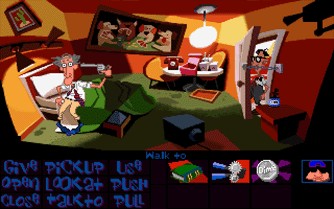So, we move onward in the fantastic library of LucasArts’ point ‘n’ click games and come to something of an oddity in the pack. It’s a half-sequel to the original Maniac Mansion, but Day of the Tentacle could actually not be any more different from its big brother. The setting’s still the same; you’re still floating around the Edison mansion trying to unravel a plot to take over the world. This time, however, you’re working with the Edisons. The SCUMM engine had come far in the six years between the two games, so, while the tried and true formula of clicking “pick up,” “use,” “push,” etc., is familiar, the graphical advancements that had taken place pushed the game to a whole new level. Think more like Monkey Island 1 & 2 and you’ll get the picture.
If it’s so similar to the games that came before it, does ANYTHING stand out in DotT? The characters moved away from the realistic figures seen in the Monkey Island games and Fate of Atlantis, and instead became very cartoony. Expressions are extremely exaggerated, characters bodies seem to defy the norm—everything is just very far-fetched, yet not to the degree that it doesn’t fit the picture. The style works well, as everything that is useful in the game is more defined. Realizing that there is a “stick” in the opening scene of Monkey Island 2 could be a bitch to someone who had never played the game before, as the item blends in so much with the background. DotT avoids this issue by making all items very individual, and colorful to boot. It at least means you always knows what’s a part of the puzzles and what’s not. Needless to say, the artistic style was a wonderful departure from the seriousness of visuals that fans of LucasArts had grown accustomed to.
As I previously mentioned, DotT follows the point-and-click-game routine of trying to find the correct items to perform various tasks and…should I really still be explaining to you exactly how a p’n’c game works?? >_> But lo and behold! An innovation! DotT took the MI2 and FoA way of playing and added in the ability to play with three different characters who are in three separates periods of time. One in the past, one in the present, and one in the future. And the best part is that they’re all in the same location, as well. Actions you perform in the past have direct consequences in later time periods. It makes for some very wicked puzzles that will truly test your noggin at times, and, if you think you’re gonna be baking some hamsters again, you’ve got another thing coming. The hamster becomes a vital part of a time-traveling puzzle, in fact! LucasArts tried something vastly different to ensure that this game was original, and it paid off.
It’s as hard as MI2 and FoA, so if you struggled furiously through them, you’ll be doing the same here. You’ll also still be feeling a great sense of satisfaction when you complete a particularly difficult puzzle, and trust me when I say the puzzles in this game are tough. When you have the right items, mind you, they’re not so bad, but the fact that you can actually swap items between the three characters through an object known as the “Chron-o-John” means that you can often find yourself a bit nonplussed as to which puzzle piece actually begins in which time period. Very frustrating at times, but it certainly ratchets up the longevity, and, if you’re enjoying yourself figuring it all out, who’s complaining?
Sound-wise, there’s a bit of a see-saw effect here, as, while you have some truly excellent voice work (with no celebs to keep you looking past the characters), the music leaves a lot to be desired. The tunes in-game no longer feel like they’re setting the mood for the area and can often just feel very unrelated. Previous LucasArts’ games have soundtracks where, if you are in a spooky location, the music is all creepy, too, to add to the atmosphere. Holiday resorts give you a glitzy feel, while deserts feel very Arabian Nights-ish. In DotT, however, the soundtrack sounds like a few fans of the original Maniac Mansion got together, drunk no doubt, and tacked together random tunes. They rarely apply to the situation you’re in.
Back to the voice work. You’ll absolutely love Bernard’s vocals, which are never annoyingly geeky. Laverne’s voice can be quite grating, but it does fit the ditzy personality she is supposed to have. Your third playable character, Hoagie, is probably the most humorous, as he has the whole “Bill and Ted” thing going on. Lots of use of the word “gnarly.” All supporting characters are also vocally worked, and you never get the feeling that one actor is portraying more than one character; they all have their own individual nuances and help draw you into the story more.
The story? Very much like Maniac Mansion, to be honest, with the bad guy plotting to take over the world through a diabolical scheme and you, as the plucky underdog, out to stop him. The more puzzles you complete, the more story that opens up to you. In fact, certain puzzles that you finish actually lead to newspaper articles that highlight the effect of what you just did on the world at large. It keeps things fresh and even makes the game feel more interactive than it really is. The story could have maybe developed the playable characters more, as, besides Bernard, who was in the original Maniac Mansion, you never really understand what the full deal is with them, which is a shame. Add to that the fact that, other than aesthetics, they’re no different from one another, and you get a slight feeling that LucasArts missed out on the potential for wackier and more creative puzzles. A huge part of Maniac Mansion is the fact that each character has their own strengths and weaknesses—different characters can solve different puzzles different ways, and, depending on who you chose, you can experience a different game each time. That’s not the case with DotT. Still, it’s not a big enough omission to have a severe effect on the game as a whole; you just can’t help but wonder if the use of three characters was even needed.
Is the game good, then? I can’t help but love it. The puzzles are some of the best that LucasArts ever developed, and the visual design of the game is just great to view. My main gripe with the game is the whole “which item in which period???” part of the puzzles, but newcomers to the game won’t notice this for quite a while and, like I did, should find a highly enjoyable (and severely underrated, if you ask me) classic hiding below the surface. If you want a fun, no-frills attached p’n’c LucasArts classic, you can’t go wrong with Day of the Tentacle. Just don’t expect to be replaying it too soon, as you’ll be sorely disappointed by the lack of difference a further playthrough brings to the table.


